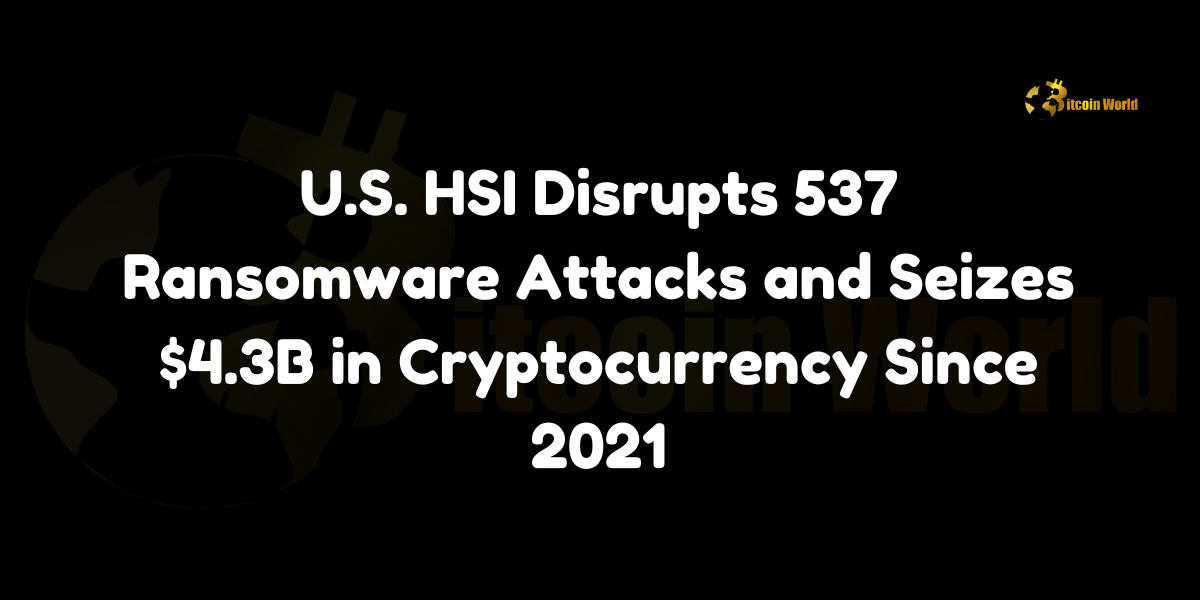HSI Disrupts 537 Ransomware Attacks and Seizes $4.3B in Cryptocurrency Since 2021
The U.S. Homeland Security Investigations (HSI) agency has achieved significant success in combating cybercrime, disrupting a staggering 537 ransomware attacks since its formation in 2021. According to a recent report by Cointelegraph, which cited an interview with Mike Prado, the deputy assistant director of HSI’s Cyber Crimes Center (C3), the agency has also seized $4.3 billion worth of cryptocurrency linked to these cyberattacks.
HSI’s ongoing efforts are part of a broader mission to crack down on the growing threats posed by ransomware and other cybercriminal activities, particularly those involving cryptocurrency, which is often the payment method of choice for cybercriminals. Since its inception, HSI’s Cyber Crimes Center has positioned itself at the forefront of the U.S. government’s efforts to protect critical infrastructure, businesses, and individuals from the damaging effects of ransomware attacks.
The Role of HSI in Cybercrime Prevention
HSI, a division of the U.S. Department of Homeland Security, plays a pivotal role in safeguarding the United States from a wide range of national security threats, including cybercrime. With the rise of ransomware attacks—where cybercriminals demand payment in cryptocurrency in exchange for unlocking encrypted data or systems—HSI has prioritized disrupting these attacks and recovering the extorted funds.
Since 2021, HSI has ramped up its efforts to investigate and dismantle ransomware operations, many of which are orchestrated by organized cybercriminal groups operating across borders. By leveraging advanced technologies and collaborating with both domestic and international partners, HSI has been able to track the flow of cryptocurrency payments made by ransomware victims, ultimately leading to the recovery of substantial amounts of funds and the disruption of hundreds of attacks.
Mike Prado, in an interview with Bloomberg, highlighted the complexity of these investigations, noting that cybercriminals often employ sophisticated tactics to anonymize their activities. However, through collaboration with blockchain analytics firms, financial institutions, and international law enforcement agencies, HSI has been able to follow the digital trails left behind by cybercriminals, leading to successful takedowns.
The Growing Threat of Ransomware
The threat posed by ransomware has become one of the most significant challenges facing businesses, governments, and individuals worldwide. Ransomware attacks involve the encryption of a victim’s data or systems, with attackers demanding cryptocurrency payments in exchange for the decryption key. These attacks can cause significant operational disruptions, financial losses, and reputational damage, particularly for businesses in sectors such as healthcare, finance, and critical infrastructure.
The widespread use of cryptocurrency in ransomware payments has added a layer of complexity to the fight against cybercrime. Cryptocurrencies like Bitcoin and Monero are often favored by cybercriminals due to their perceived anonymity and ease of transfer across borders. This has made it more challenging for law enforcement agencies to track and recover funds in the wake of an attack.
However, as Prado explained, HSI has developed sophisticated tools and methods to trace cryptocurrency transactions, even across multiple layers of anonymization. The seizure of $4.3 billion in extorted cryptocurrency since 2021 is a testament to the agency’s ability to navigate the challenges posed by crypto-related cybercrime.
HSI’s Collaboration with Global Partners
One of the key factors behind HSI’s success in disrupting ransomware attacks has been its strong collaboration with international law enforcement agencies and private sector partners. Ransomware is a global problem, with many of the most sophisticated cybercriminal groups operating out of countries with weak or non-existent cybercrime laws. As a result, HSI has worked closely with global partners to track down these groups and bring them to justice.
In addition to its partnerships with foreign governments and law enforcement agencies, HSI has also teamed up with leading blockchain analytics firms and cybersecurity companies. These collaborations have provided the agency with access to cutting-edge tools and expertise, enabling it to analyze blockchain data and trace the movement of funds across multiple platforms and wallets.
HSI’s efforts have not only disrupted ransomware attacks but have also led to the identification of key players within cybercriminal organizations. Through these investigations, HSI has been able to dismantle criminal infrastructure, arrest perpetrators, and recover funds for victims of ransomware attacks.
The Seizure of $4.3 Billion in Cryptocurrency
The seizure of $4.3 billion in cryptocurrency is a major milestone in HSI’s fight against ransomware. Cryptocurrency has become the lifeblood of ransomware operations, allowing cybercriminals to extort victims while maintaining a degree of anonymity. However, through persistent efforts, HSI has been able to identify and seize a substantial portion of the funds that cybercriminals have attempted to launder through the cryptocurrency ecosystem.
While $4.3 billion represents a significant recovery, it is important to note that this figure likely represents only a fraction of the total amount extorted by ransomware groups since 2021. Many victims choose to pay ransoms in order to regain access to their data, often without reporting the incident to law enforcement. As a result, the true scale of the ransomware economy remains difficult to quantify.
Nevertheless, HSI’s efforts to recover funds have provided much-needed relief to victims, many of whom face crippling financial losses in the wake of an attack. By seizing these funds, HSI has also deprived ransomware groups of their illicit profits, disrupting their operations and preventing further attacks.
Challenges Ahead
Despite HSI’s successes, the fight against ransomware is far from over. Cybercriminals continue to evolve their tactics, developing new techniques to anonymize their activities and evade detection. The rise of decentralized finance (DeFi) platforms, privacy-focused cryptocurrencies, and sophisticated money laundering schemes has made it increasingly difficult for law enforcement agencies to track the flow of funds in the crypto ecosystem.
In addition to technical challenges, HSI and other law enforcement agencies face jurisdictional hurdles in pursuing cybercriminals operating across borders. Many ransomware groups are based in countries that do not have strong cybercrime laws or extradition agreements with the U.S., making it difficult to bring perpetrators to justice.
However, as Mike Prado emphasized, HSI remains committed to evolving its capabilities and deepening its partnerships to stay ahead of cybercriminals. The agency’s work in blockchain analytics, cyber forensics, and international cooperation will be critical in the ongoing battle against ransomware and other forms of crypto-enabled cybercrime.
Conclusion
Since its establishment in 2021, HSI’s Cyber Crimes Center has made remarkable strides in combating ransomware attacks, disrupting 537 cyberattacks and seizing $4.3 billion in cryptocurrency. These efforts have not only safeguarded businesses and individuals but also highlighted the importance of international cooperation and advanced blockchain analytics in the fight against cybercrime.
As ransomware continues to pose a significant threat, HSI’s work will be instrumental in protecting the digital infrastructure of the United States and the global economy. With a commitment to innovation and collaboration, HSI is well-positioned to lead the charge against cybercriminals and ensure a safer future for all.
To learn more about the innovative startups shaping the future of the crypto industry, explore our article on latest news, where we delve into the most promising ventures and their potential to disrupt traditional industries.





